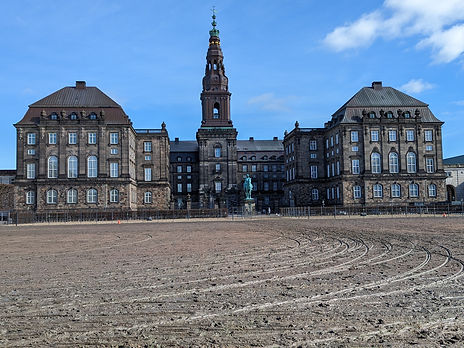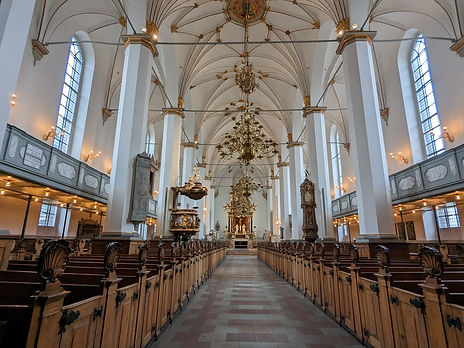
Denmark
Walking around Copenhagen; following wide avenues with 5 story stone buildings, this feels very continental at times. Then, there are red brick buildings, or colorful boathouses on a canal, and it feels very Scandinavian. So, to me, Denmark is where the continent meets Scandinavia.

Palaces abound
Christiansborg, Fredericksburg Palace, and Amalienborg which is five palaces in one. There are plenty to see.
Seas and canals
Denmark is located between the North Sea and Baltic Sea, so there is plenty of water around. The part of Denmark where Copenhagen is located, is on an island, after all.

Copenhagen
In Denmark, From the 9th to the 11th century, there were hundreds of years of Viking rulers of a large empire. The Danish Viking Sweyn Forkbeard (Svend Tveskæg) and his son Canute the Great (Knud den Store) were the kings not only of Denmark but of Norway, Southern Sweden, Greenland, the Faroe Islands, Shetland, Orkney and parts of England. After the Viking age, Denmark became a land ruled by monarchs.
Founded nearly a millennium ago ago, this city of about 600,000 people was founded as a Viking fishing village in 1167 and became the capital of Denmark in the 15th century, and also the capital for Norway by the 17th century.
Today, it is an extremely inviting capital, easy to navigate, with a lot to see. But, it is not so large as to be overly crowded and busy.






Getting around Copenhagen
Like all Scandinavian cities, there is an app for that. (DOT). But, for the first time in a while, I bought a city pass that gave me unlimited metro travel for a few days. I would love to say I was forward thinking and wanted to save money; but the reality is that I simply couldn't get the app to work. But, it worked out as I paid about $28 USD for 72 hours of travel. and, that includes the airport. So, it is a pretty good deal. If you plan to visit many places, for an even better deal, you can buy the Copenhagen Card. It gives you free transportation plus free entry to 80 tourist sites (Discover version costs $US 70-168 for 1 to 5 days in 2024) ...or to 40 tourist sites plus hop on hop off busses (HOP version costs $US 80-133 for 1 to 3 days)
Like other cities in the north, public transportation is an honor system. Just get on and off without presenting your ticket. However, if you get caught without a ticket by a random inspection, the fine is hefty. In 2024, the fine is 1000 Krone (about $145 USD). So, have your ticket with you!
With a combination of above ground trams, underground metro, and busses, there is transportation available everywhere. Like most European capitals, I never used cars while visiting.
Getting to Copenhagen
If you are in Northern Europe, it is quite easy to get to Copenhagen. By train it is just 4.5 hours from Hamburg or 5 hours from Stockholm. During my trip, I happened to be in Bergen, Norway before Copenhagen so I used one of the many discount airlines in Europe and paid less than $150 for a flight including baggage. Though, if I wanted to, I could have taken a 14 hour train ride through Oslo and Gothenburg.
Staying in Copenhagen
As with most places in Europe, once I arrived I stayed in an Airbnb outside the city center. During this trip, I found the Valby neighborhood perfect. I do this for many reasons. It is less expensive (even more important in Scandinavia, where prices can be a it high), the public transport makes it easy to get to the center, it is normally quieter at night, markets and restaurants will have lower prices outside the center also. I find those trade offs well worth it to spend and extra 15 to 30 minutes on the metro each day. Plus, I enjoy looking around while on the metro anyway. You can really get a feel for a city passing through the parts that are not set up for tourism.
Christiansborg Palace
This is Denmark's all in one palace. It is used by the monarchy; but is also the home of the Prime Minister office, the Supreme Court, and Parliament.
Supposedly, it is the only building in the world that houses all 3 branches of a nation's government.
The first castle here was built in 1167, and parts of that can still be seen. But, there have been additions throughout the centuries, right up to the 19th century.
You can buy tickets to visit various parts of the castle including the reception halls, kitchen, stables and ruins. The best deal is to get a combination ticket for all which, in 2024, costs 175 Krone (about $26 USD). While Parliament is in session, access to the public galleries is free.
If you have the Copenhagen Card, it includes entrance to all parts.


Amalienborg Winter Residence
Amalienborg was originally built for four noble families; however, when Christiansborg Palace burned in 1794, the royal family bought the palaces and moved in. The first palace was named for Queen Sophie Amalie, whose original palace burned down during the birthday celebration of Christian V.
But, since the royals took over, the 4 palaces have been renamed for successive Kings. Christian VII, Christian VIII, Frederick VIII and Christian IX. The royals intended to stay temporarily until they could rebuild their palace, but they ended up staying even after the rebuild of Christiansborg.
If you like, you can prepare with a virtual your.
https://my.matterport.com/show/?m=MysS1djaBrQ&hl=1&help=1


Rosenberg Castle and King's Garden
Originally built as a country summerhouse in 1606, and expanded for decades to reach its current state in 1624. It was used as a royal residence until 1710. Today, it is open for tourists and houses the Danish Crown Jewels and the coronation chair. As well, it is surrounded by the country's oldest royal gardens.




The Round Tower and Trinity Church
Rundetaarn, a 17th-century tower, built by Christian IV, it was constructed as an astronomical observatory between 1637 and 1642. Today, you can ascend the rounding ramp to see great views of Copenhagen, and pick up little history lessons along the way up. (But, beware, there is no elevator.) Halfway up the Round Tower on the floor above the Trinity Church you find the Library Hall, which houses changing exhibitions of art and design plus concerts and cultural events. At the top of the Round Tower you find the oldest functioning observatory in Europe. So, you see, there are many reasons to visit The Tower.
It is attached to the beautiful Trinity Church, also worth a stop. The name "trinity" comes from the fact that it was designed to house the church, the royal book collection and an observatory. The king himself was very active in the design and even drew the rebus on the front of the tower. However, despite the stone on site that says the King laid the cornerstone, it is not true. Records show that the King was in Holstein that day. Oh, well, we can allow for some literacy hyperbole.
The church was intended to be for the students and professors of the University, but it did not come with a parish and a way of making income. So, eventually the connection to the university weakened and it became solely a parish church in 1869.
If you want an early glimpse, here is a virtual tour of the tower... https://www.rundetaarn.dk/en/virtual-tour/




Kronborg Castle and Helsingor
Located about an hour metro ride north of Copenhagen; this 16th century castle was built on a tip of land across from Sweden on the grounds of the fortress of Erik of Pomerania dated from 1400-1420. Used for 200 years as a part time royal residence; After 1783, the castle was mostly used as a military barracks. Visiting Kronborg can be turned into a nice little day trip.
To get there, take the RE line north from Copenhagen to the last stop at Helsingor. You will find yourself in a lovely small town with plenty of charm to walk around and enjoy. The castle entrance is about a 15 minute walk from the train station, and along the way you an stop by the St. Olaf and St Mary's church. And, also visit the Skibsklarerergaarden history museum, the Danish Museum of Science and Technology in town and the Maritime Museum just outside the castle. For a quick snack, there is a cafe in the Maritime Museum, and Cafe Brohus next to the castle and of course, plenty of restaurants right in the town center.
Don't miss the Øresund Aquarium for wonderful whale exhibits, and even on a cold day, take the opportunity to walk the path around the castle for the sea views just a couple miles across the water to Helsingborg, Sweden.





